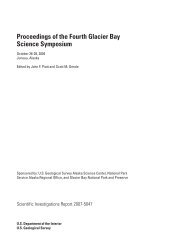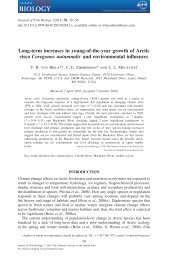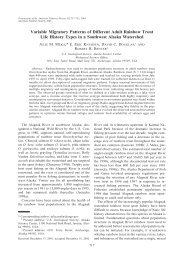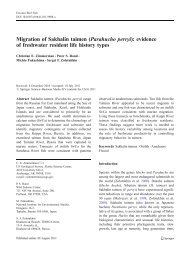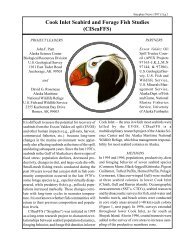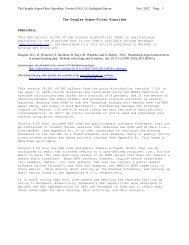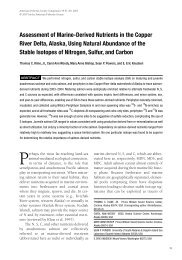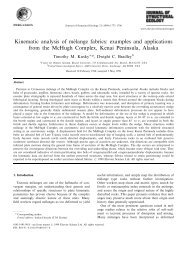Mexican native trouts: a review of their history and ... - Webspace
Mexican native trouts: a review of their history and ... - Webspace
Mexican native trouts: a review of their history and ... - Webspace
You also want an ePaper? Increase the reach of your titles
YUMPU automatically turns print PDFs into web optimized ePapers that Google loves.
306<br />
Yaqui (Sirupa – Aros) sub-basin, which harbors its<br />
own, distinct, <strong>native</strong> trout (Hendrickson et al., 1981;<br />
Minckley et al., 1986; Nielsen, 1997), though collections<br />
<strong>of</strong> the southern Yaqui form from the immediate<br />
vicinity <strong>of</strong> the stream receiving the transplant are not<br />
known.<br />
Our subsequent explorations revealed additional,<br />
but previously unpublished, evidence <strong>of</strong> inter- <strong>and</strong><br />
intrabasin transplants. In 1998, reports <strong>of</strong> two earlier<br />
transplants <strong>of</strong> trout from the Río Yaqui basin eastward<br />
across the continental divide to the Guzmán<br />
system were related to one <strong>of</strong> us (BJ) by long-time<br />
area resident Elvin Whetten at his Rancho Gavilán<br />
on the Río Gavilán (Yaqui/Bavispe drainage). Mr.<br />
Whetten, in his 80s at the time <strong>of</strong> the interview, grew<br />
up in Colonia García, about 30 miles SSE <strong>of</strong> his Río<br />
Gavilán ranch. He related that trout from the Río<br />
Gavilán were transplanted to the “Hop Valley”, now<br />
known as the “Jovales” or “Hernández Jovales”, a<br />
tributary <strong>of</strong> the Río Piedras Verdes (tributary <strong>of</strong> the<br />
Río Casas Gr<strong>and</strong>es <strong>of</strong> the Guzmán system) between<br />
1905 <strong>and</strong> 1910. The mother <strong>and</strong> uncle <strong>of</strong> one <strong>of</strong><br />
us (BJ) grew up with Mr. Whetten, <strong>and</strong> regularly<br />
fished the upper headwaters <strong>of</strong> the Piedras Verdes,<br />
several miles upstream from Jovales, during the late<br />
1920s <strong>and</strong> early 1930s. They referred to the stream as<br />
“Pacheco Creek” since it continued down to Colonia<br />
Pacheco, <strong>and</strong> indicated that trout were very abundant;<br />
“if you didn’t catch at least a hundred fish a day,<br />
you weren’t much <strong>of</strong> a fisherman!” This successful<br />
transplant therefore was likely the source <strong>of</strong> specimens<br />
we collected from Arroyo Escalariado (Table 1), <strong>and</strong>,<br />
indeed, molecular analyses <strong>of</strong> specimens from that site<br />
determined them to be very close to specimens from<br />
the upper Río Bavispe (Nielsen, 1997), thus agreeing<br />
with close morphological similarities earlier noted by<br />
others (Needham <strong>and</strong> Gard, 1959; Smith <strong>and</strong> Miller,<br />
1986) <strong>and</strong> the purported transplant.<br />
The other transplant related by Mr. Whetten took<br />
place in the mid 1930s when BJ’s maternal gr<strong>and</strong>father<br />
<strong>and</strong> his brothers were operating a sawmill at<br />
Rancho Bella Vista on the hill above Arroyo La Playa,<br />
a tributary <strong>of</strong> El Álamo, which flows to the Río<br />
Casas Gr<strong>and</strong>es (Guzmán system). One <strong>of</strong> the men<br />
at the mill went to the Río Negro (Yaqui/Bavispe<br />
drainage) <strong>and</strong> brought back trout, releasing them in<br />
La Playa. Presumably, therefore, specimens that we<br />
collected from Arroyo La Playa on September 27,<br />
1996, <strong>and</strong> those collected earlier near the same locality<br />
by Needham <strong>and</strong> Gard (Table 1), stemmed from this<br />
introduction.<br />
Further south, our local guide in the Río Presidio<br />
basin, Miguel-Ángel Molina-Rodríguez, reported that<br />
he <strong>and</strong> family members had transplanted trout between<br />
two headwaters <strong>of</strong> the Río Presidio, from Arroyo<br />
Nogales to Arroyo El Rincón. We obtained specimens<br />
from both streams in October 2000 (Table 1).<br />
Even more recently, M.V.Z. Gerardo Zamora<br />
advised (pers. comm. to Hendrickson, 2001) that<br />
in October 1999, 50 mature <strong>native</strong> trout specimens<br />
were captured <strong>and</strong> transported alive from the<br />
“Río Chuhuichupa” <strong>and</strong> “Guaynopa” (Table 1) in<br />
Chihuahua, to his place <strong>of</strong> employment, the Centro<br />
Nacional de Investigación en Acuacultura “El Zarco”<br />
in the Distrito Federal (far outside <strong>of</strong> presumed<br />
<strong>native</strong> trout range). Specimens <strong>of</strong> these now captive<br />
stocks have been deposited in the Fish Collection<br />
<strong>of</strong> IB-UNAM (Table 1). According to M.V.Z.<br />
Zamora, reproduction in captivity has occurred, but<br />
both the brood stock <strong>and</strong> <strong>of</strong>fspring are “nervous<br />
<strong>and</strong> aggressive” <strong>and</strong> refuse to take prepared foods.<br />
Evaluation <strong>of</strong> the adaptability <strong>of</strong> these stocks <strong>and</strong><br />
<strong>their</strong> hybrids with hatchery rainbows continues at “El<br />
Zarco” (M.V.Z. Zamora, pers. comm.).<br />
Discussion<br />
Current status <strong>of</strong> knowledge <strong>of</strong> distribution <strong>and</strong><br />
abundance<br />
Current knowledge <strong>of</strong> distribution <strong>and</strong> abundance <strong>of</strong><br />
<strong>native</strong> <strong>trouts</strong> in the study area remains inadequate.<br />
Only in the Yaqui basin, <strong>and</strong> perhaps in the Mayo,<br />
has sampling been anywhere near comprehensive, yet<br />
still inadequate. Other basins remain grossly undersurveyed,<br />
<strong>and</strong> now, with the threat <strong>of</strong> increasing<br />
rainbow trout introductions, documentation <strong>of</strong> the<br />
distribution <strong>of</strong> both <strong>native</strong>s <strong>and</strong> non-<strong>native</strong>s takes on<br />
new importance. We must now consider all trout<br />
streams throughout our study area to be imminently<br />
threatened by the introduction <strong>of</strong> rainbows. The<br />
numbers <strong>and</strong> distribution <strong>of</strong> rainbow trout growout<br />
<strong>and</strong> fry production facilities in northwestern Mexico<br />
are rapidly increasing, <strong>and</strong> they are appearing in<br />
more <strong>and</strong> more remote locations. In 2001 one <strong>of</strong> us<br />
(BJ) documented three new rainbow trout growout<br />
facilities in the upper Río Yaqui basin (Río Bavispe<br />
sub-basin); at El Colorado in the Río Gavilán headwaters,<br />
in the Río La Cueva, <strong>and</strong> in the Río San<br />
Antonio. About the same time a colleague, Arny<br />
Stonkus, who has many times traveled to remote areas




